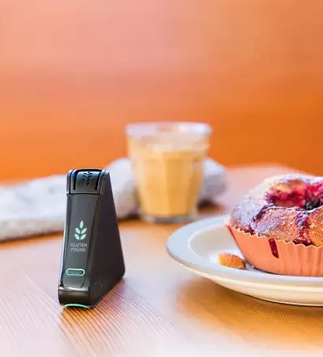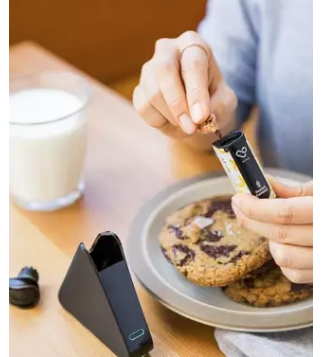Nima Gluten-Free Sensor Gets Mixed Review
“The Nima Gluten Sensor seems a marvelous little gadget, and I could see how it would come in handy at restaurants where I couldn’t trust waitstaff to know the intricacies of a gluten-free diet. That said, the imagined security I would have didn’t seem to outweigh what I perceived to be genuine problems with the device.”
- excerpted from Popular Science article by Sara Chodosh 1
 Anyone who regularly pesters waiters about their food allergies generally wants to minimize their own presence. I hate having to ask whether fries are cooked in a contaminated fryer, then having to refuse them and insist that a side salad is an acceptable alternative to crispy potatoes. I hate forcing staff to ask the chef questions. I hate sending cheese plates back because the bread was touching my brie. I hate every moment that I am a bother to someone contractually obligated to be nice to me, even as I make their job harder.
Anyone who regularly pesters waiters about their food allergies generally wants to minimize their own presence. I hate having to ask whether fries are cooked in a contaminated fryer, then having to refuse them and insist that a side salad is an acceptable alternative to crispy potatoes. I hate forcing staff to ask the chef questions. I hate sending cheese plates back because the bread was touching my brie. I hate every moment that I am a bother to someone contractually obligated to be nice to me, even as I make their job harder.
- For starters, to whip out a device and test the food I’d already questioned them about was a thought so unbearable that I convinced myself I’d never do it.
- It doesn’t help that the sensor in question is surprisingly loud. It whirs and clicks as it processes the requisite pea-sized lump of food (which I never managed to fit into the capsule without making a mess).
- There are tiny prongs inside the chamber designed to hold the food in place, but to me they just seemed to get in the way. And it never held enough, anyway.
- To test a burger, I had to choose whether I thought the bun or meat was more likely to be contaminated, since chunks of both would be too large to fit. I could test each separately, but the capsules cost $6 a pop. Any dish with more than a couple components seemed impossible to test fully.
- You also have to wait several agonizing minutes for the test to finish. The base must sit undisturbed on your table the whole time, like a triangular beacon informing everyone nearby that you are special. It’s attention-grabbing in a way I think most people with allergies strive their hardest not to be.
- Plus, it’s limited. Nima can’t find the gluten in soy sauce or in any kind of alcoholic beverage, because the fermenting process renders gluten somehow undetectable by sensor (yet 100-percent detectable by my gut).
- It’s not cheap—$289 just for the base—so I can understand why people might be hesitant to buy in (or simply unable to do so). It’s a big up-front cost for a device that you can’t test out yourself. .
And then, perhaps worst of all, what happens if it finds gluten?
 Do I send the food back? I’d have to explain to my waiter—who I imagine is already annoyed—that I have this little device that has informed me their food which claims to be gluten-free is in fact, not. That I can’t eat this dish now. That I’m so truly sorry. If the source of gluten is cross-contamination, I have no idea how they’d even go about preparing an option that I could safely eat, nor any idea if I’d feel comfortable eating there at all. I probably wouldn’t, or at least wouldn’t want to trouble anyone for another plate, which would leave me to smell other people’s food and salivate in silence.
Do I send the food back? I’d have to explain to my waiter—who I imagine is already annoyed—that I have this little device that has informed me their food which claims to be gluten-free is in fact, not. That I can’t eat this dish now. That I’m so truly sorry. If the source of gluten is cross-contamination, I have no idea how they’d even go about preparing an option that I could safely eat, nor any idea if I’d feel comfortable eating there at all. I probably wouldn’t, or at least wouldn’t want to trouble anyone for another plate, which would leave me to smell other people’s food and salivate in silence.
But despite all these reservations (restaurant pun intended), I coughed up the cash in August. I had brought home suspect leftovers which I obsessively froze in a small ziploc bag to test when my sensor arrived. By September I had the answer: my beloved lobster mac had poisoned my gut—and the idea of ever eating at that restaurant again.
I’ve used my Nima only sparingly in the intervening months, and it still has those same issues that once gave me pause. It is loud. It draws attention. It is hard to cram food in the capsules, and they don’t hold very much to begin with.
But I’m still glad I bought it. For me, the value isn’t in the ability to regularly test my food, but to have a back-up in those instances where I want or need to eat what’s in front of me, and yet have a terrible feeling that I’m about to regret it.
This isn’t like most tech purchases, where the amount you use the device has a direct correlation to how valuable you’ll find it. You may only use a sensor like Nima once a month or even once a year, but the mental security in knowing that you are able to test your food is unparalleled. I imagine this would only be more true if you have an anaphylactic response to allergens, rather than a digestive one.
1Read the entire article at https://www.popsci.com/nima-allergen-sensor-peanuts-gluten










